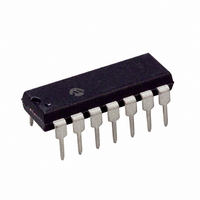PIC16F688-E/P Microchip Technology, PIC16F688-E/P Datasheet - Page 26

PIC16F688-E/P
Manufacturer Part Number
PIC16F688-E/P
Description
IC MCU PIC FLASH 4KX14 14DIP
Manufacturer
Microchip Technology
Series
PIC® 16Fr
Datasheets
1.PIC16F616T-ISL.pdf
(8 pages)
2.PIC16F688T-ISL.pdf
(204 pages)
3.PIC16F688T-ISL.pdf
(6 pages)
4.PIC16F688T-ISL.pdf
(4 pages)
5.PIC16F688T-ISL.pdf
(688 pages)
6.PIC16F688-EP.pdf
(174 pages)
Specifications of PIC16F688-E/P
Program Memory Type
FLASH
Program Memory Size
7KB (4K x 14)
Package / Case
14-DIP (0.300", 7.62mm)
Core Processor
PIC
Core Size
8-Bit
Speed
20MHz
Connectivity
UART/USART
Peripherals
Brown-out Detect/Reset, POR, WDT
Number Of I /o
12
Eeprom Size
256 x 8
Ram Size
256 x 8
Voltage - Supply (vcc/vdd)
2 V ~ 5.5 V
Data Converters
A/D 8x10b
Oscillator Type
Internal
Operating Temperature
-40°C ~ 125°C
Processor Series
PIC16F
Core
PIC
Data Bus Width
8 bit
Data Ram Size
256 B
Interface Type
SCI/USART
Maximum Clock Frequency
20 MHz
Number Of Programmable I/os
12
Number Of Timers
2
Operating Supply Voltage
2 V to 5.5 V
Maximum Operating Temperature
+ 125 C
Mounting Style
Through Hole
3rd Party Development Tools
52715-96, 52716-328, 52717-734
Development Tools By Supplier
PG164130, DV164035, DV244005, DV164005, PG164120, ICE2000, DM163014, DM164120-4
Minimum Operating Temperature
- 40 C
On-chip Adc
8-ch x 10-bit
Lead Free Status / RoHS Status
Lead free / RoHS Compliant
For Use With
AC162066 - HEADER INTRFC MPLAB ICD2 20PINAC162061 - HEADER INTRFC MPLAB ICD2 20PINDM163029 - BOARD PICDEM FOR MECHATRONICSAC162056 - HEADER INTERFACE ICD2 16F688ACICE0207 - MPLABICE 14P 300 MIL ADAPTER
Lead Free Status / Rohs Status
Lead free / RoHS Compliant
PIC16F688
3.3.4
The External Resistor-Capacitor (RC) modes support
the use of an external RC circuit. This allows the
designer maximum flexibility in frequency choice while
keeping costs to a minimum when clock accuracy is not
required. There are two modes, RC and RCIO.
In RC mode, the RC circuit connects to the OSC1 pin.
The OSC2/CLKOUT pin outputs the RC oscillator
frequency divided by 4. This signal may be used to
provide a clock for external circuitry, synchronization,
calibration, test or other application requirements.
Figure 3-5 shows the RC mode connections.
FIGURE 3-5:
In RCIO mode, the RC circuit is connected to the OSC1
pin. The OSC2 pin becomes an additional general
purpose I/O pin. The I/O pin becomes bit 4 of PORTA
(RA4). Figure 3-6 shows the RCIO mode connections.
FIGURE 3-6:
The RC oscillator frequency is a function of the supply
voltage, the resistor (R
values and the operating temperature. Other factors
affecting the oscillator frequency are:
• threshold voltage variation
• component tolerances
• packaging variations in capacitance
The user also needs to take into account variation due
to tolerance of external RC components used.
DS41203B-page 24
R
C
C
R
V
Recommended values: 3 k
Recommended values: 3 k
V
EXT
EXT
EXT
EXT
SS
SS
V
V
DD
DD
RA4
EXTERNAL RC MODES
F
OSC
/4
OSC1
RCIO MODE
OSC1
OSC2/CLKOUT
RC MODE
I/O (OSC2)
C
C
EXT
EXT
EXT
> 20 pF
> 20 pF
) and capacitor (C
R
R
EXT
EXT
PIC16F688
PIC16F688
100 k
100 k
Internal
Internal
Clock
Clock
EXT
Preliminary
)
3.4
The PIC16F688 has two independent, internal
oscillators that can be configured or selected as the
system clock source.
1.
2.
The system clock speed can be selected via software
using the Internal Oscillator Frequency Select (IRCF)
bits.
The system clock can be selected between external or
internal clock sources via the System Clock Selection
(SCS) bit (see Section 3.5 “Clock Switching”).
3.4.1
The INTRC and INTRCIO modes configure the internal
oscillators as the system clock source when the device
is programmed using the Oscillator Selection (FOSC)
bits in the Configuration Word register (Register 11-1).
In INTRC mode, the OSC1 pin is available for general
purpose I/O. The OSC2/CLKOUT pin outputs the
selected internal oscillator frequency divided by 4. The
CLKOUT signal may be used to provide a clock for
external circuitry, synchronization, calibration, test or
other application requirements.
In INTRCIO mode, the OSC1 and OSC2 pins are
available for general purpose I/O.
3.4.2
The High-Frequency Internal Oscillator (HFINTOSC) is
a factory calibrated 8 MHz internal clock source. The
frequency
approximately ±12% via software using the OSCTUNE
register (Register 3-1).
The output of the HFINTOSC connects to a postscaler
and multiplexer (see Figure 3-1). One of seven
frequencies can be selected via software using the
IRCF bits (see Section 3.4.4 “Frequency Select Bits
(IRCF)”).
The HFINTOSC is enabled by selecting any frequency
between 8 MHz and 125 kHz (IRCF
system clock source (SCS = 1), or when Two-Speed
Start-up is enabled (IESO = 1 and IRCF
The HF Internal Oscillator (HTS) bit (OSCCON<2>)
indicates whether the HFINTOSC is stable or not.
The
Oscillator) is factory calibrated and operates at
8 MHz. The frequency of the HFINTOSC can be
user adjusted ±12% via software using the
OSCTUNE register (Register 3-1).
The
Oscillator) is uncalibrated and operates at
approximately 31 kHz.
Internal Clock Modes
INTRC AND INTRCIO MODES
HFINTOSC
LFINTOSC
HFINTOSC
of
the
HFINTOSC
2004 Microchip Technology Inc.
(High-Frequency
(Low-Frequency
can
000) as the
000).
be
Internal
Internal
altered














